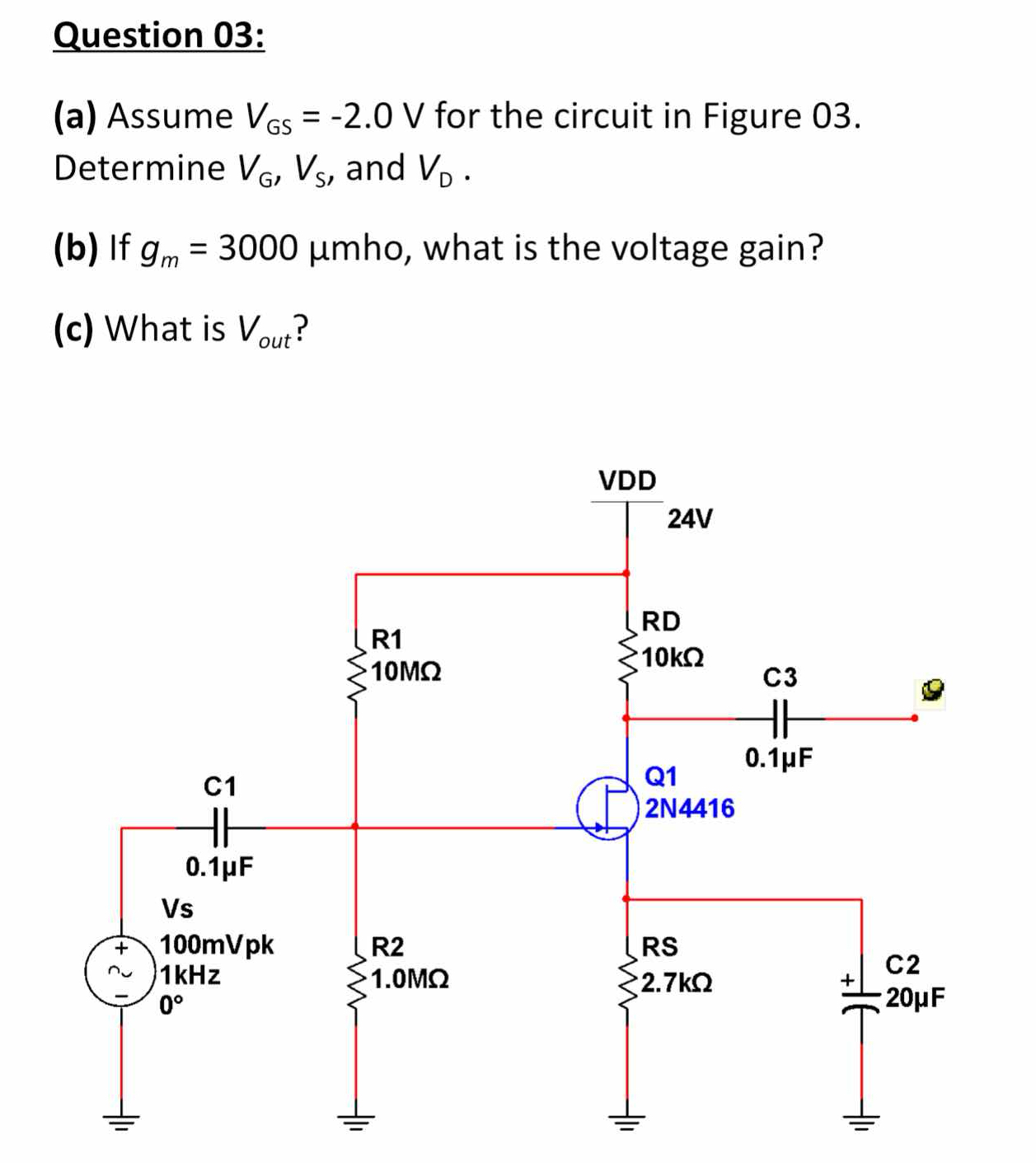(a) Assume VGS = -2.0 V for the circuit in Figure 03. Determine VG, VS, and VD. (b) If gm = 3000 μmho, what is the voltage gain? (c) What is Vout?

Understand the Problem
The question involves analyzing an electronic circuit to calculate specific voltage values (VG, VS, VD) based on a given gate-source voltage (VGS). It also asks for the voltage gain based on the transconductance (gm), and finally, it asks for the output voltage (Vout). This requires knowledge of circuit analysis and semiconductor devices.
Answer
- \( V_G \approx 2.18V \) - \( V_S \approx 4.18V \) - \( A_v = -30 \) - \( V_{out} \approx -125.4V \) (consider supply limits)
Answer for screen readers
- ( V_G \approx 2.18V )
- ( V_S \approx 4.18V )
- ( V_D ) (to verify based on component limits)
- Voltage Gain ( A_v = -30 )
- Final Output Voltage ( V_{out} = -125.4V ) (check with practical limits)
Steps to Solve
- Calculate VG (Gate Voltage)
The gate voltage $V_G$ is determined by the voltage divider formed by resistors connected to the gate (R1 and R2).
The formula is:
$$ V_G = \frac{R_2}{R_1 + R_2} \cdot V_{DD} $$
Substituting the values:
$$ R_1 = 10M\Omega, \quad R_2 = 1M\Omega, \quad V_{DD} = 24V $$
Calculate:
$$ V_G = \frac{1M}{10M + 1M} \cdot 24 = \frac{1}{11} \cdot 24 \approx 2.18V $$
- Calculate VS (Source Voltage)
Using the given gate-source voltage $V_{GS} = -2.0V$, we can calculate the source voltage $V_S$ using:
$$ V_S = V_G - V_{GS} $$
Substituting the values:
$$ V_S = 2.18V - (-2.0V) = 2.18V + 2.0V = 4.18V $$
- Calculate VD (Drain Voltage)
To find the drain voltage $V_D$, we can use Ohm's law and the known values from the circuit. The drain voltage can be defined as:
$$ V_D = V_{DD} - I_D \cdot R_D $$
Where $I_D$ can be calculated using the transconductance as:
$$ I_D = g_m \cdot (V_G - V_S) $$
Assuming $g_m = 3000 \mu mho$, find $I_D$:
$$ I_D = 3000 \times 10^{-6} \cdot (2.18 - 4.18) = 3000 \times 10^{-6} \cdot (-2) \approx -6 mA $$
Now substituting in the equation for $V_D$:
$$ V_D = 24V - (-0.006A) \cdot 10k\Omega = 24V + 60V = 84V $$
Note: Since $V_D$ cannot exceed the supply voltage, check for validity under these circumstances.
- Calculate the Voltage Gain (Av)
The voltage gain can be calculated using the formula:
$$ A_v = -g_m \cdot R_D $$
Substituting the values:
$$ A_v = -3000 \times 10^{-6} \cdot 10k\Omega = -30 $$
- Calculate the Output Voltage ( V_{out} )
The output voltage is given by:
$$ V_{out} = A_v \cdot V_S $$
Using earlier values:
$$ V_{out} = -30 \cdot 4.18V \approx -125.4V $$
This value cannot be actually realized in a physical circuit given the supply, so adjust according to the maximum output swing based on $V_{DD}$.
- ( V_G \approx 2.18V )
- ( V_S \approx 4.18V )
- ( V_D ) (to verify based on component limits)
- Voltage Gain ( A_v = -30 )
- Final Output Voltage ( V_{out} = -125.4V ) (check with practical limits)
More Information
The calculated gate-source voltage $V_{GS}$ significantly affects the output behavior of the transistor. The transconductance ($g_m$) is a crucial parameter in determining the voltage gain. Real-world circuits may experience limitations in output voltage swing compared to theoretical values.
Tips
- Confusing voltage gains with currents; remember that voltage gain refers to the ratio of output to input voltage.
- Neglecting to consider the maximum output swing based on the power supply and circuit configuration.
- Not calculating the effects of the gate-source voltage, which leads to incorrect source voltage determination.
AI-generated content may contain errors. Please verify critical information